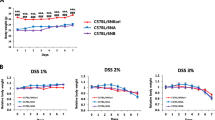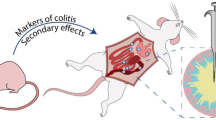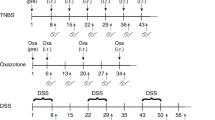Abstract
Inflammatory bowel diseases (IBDs) are complex multifactorial disease thought to result from inappropriate immune responses to the gut microbiota, in genetically susceptible individuals, under the influence of environmental factors. Among the different animal models developed to help in understanding IBDs pathophysiological mechanisms as well as to achieve pharmacological preclinical studies, the dextran sulfate sodium (DSS)-induced colitis model is the most widely used because of its simplicity, cost-effectiveness, and similarity with human IBDs. This section provides with a detailed protocol that we validated in our laboratory to perform DSS-induced acute colitis in the Sprague-Dawley (SPD) rat.
Access provided by CONRICYT – Journals CONACYT. Download protocol PDF
Similar content being viewed by others
Key words
- Colitis
- Animal models
- Rats
- Dextran sodium sulfate
- Inflammatory bowel disease
- Crohn’s disease
- Ulcerative colitis
1 Introduction
Crohn’s disease (CD) and ulcerative colitis (UC) , the two major clinically defined forms of inflammatory bowel diseases (IBDs), are chronic remittent or progressive disorders of the gastrointestinal tract, with an estimated prevalence of 250 cases per 100,000 individuals in Western countries [1, 2]. Both CD and UC are characterized by intestinal inflammation and epithelial injury and are mediated by shared and distinct inflammatory pathways [3]. Etiology of IBDs is still not fully understood but it is wi dely acknowledged that they result from inappropriate and/or deregulated immune respons es to the commensal gut microbiota, in genetically predisposed individuals and under the influence of environmental lifestyle factors [3]. Understanding these complex interactions is of importance in order to develop new targeted therapies of clinical interest that are still deeply of need. To achieve this, animal models of IBDs represent contributive tools as they allow manipulations and interventions that are not possible with human studies [4]. Among them, the dextran sulfate sodium (DSS)-induced colitis model is the most widely used one as beyond its shared characteristics with human IBDs etiology, pathogenesis, and therapeutic response, it is relatively simple, rapid to set up, and cost effective.
DSS is a sulfated polysaccharide whose colitogenic properties were first reported in hamsters [5] and extrapolated a few years later to mice [6] and rats [7, 8]. The exact mechanisms through which DSS induces intestinal inflammation are unclear but may be the result of direct damage of the monolayer of epithelial cells in the colon, leading to the crossing of intestinal contents (e.g., commensal bacteria and their products) into underlying tissue and therefore induction of inflammation [9]. Clinical manifestations of the colitis usually include watery diarrhea, occult blood in stools, and weight loss. In the acute model, rectal bleeding and diarrhea may occur as early as 2–3 days following DSS administration and inflammation is fully installed within 6–7 days. Animals then recover if DSS administration is stopped, allowing the study of gut epithelium healing. Weight loss starts 4–5 days following the initiation of DSS-treatment and continues over the next few days, including 4–5 days after DSS remo va l. Importantly, the DSS model is not dependent on adaptive immunity and is thus useful to analyze the contribution of the innate immune system to the installation of intestinal inflammation [10]. Inflammation is normally limited to the colon with some species-dependent variations [9]. Histopathological findings closely resemble that of human IBDs, especially UC [6], but the inflammatory environment created includes features of both CD and UC [11]. Finally, the DSS-induced colitis has been validated as a relevant model for testing of therapeutic compounds of interest to treat hu man disease [12].
In this chapter we describe the procedure we have validated in our laboratory to perform DSS-induced colitis in SPD rats.
2 Materials
-
1.
Sprague-Dawley male rats (Centre d’Elevage Janvier, Le Genest-St Isle, France) 7–9 weeks old (w eighing 170–200 g) (see Note 1 ).
-
2.
4.5–6.0 % w/v dextran sulfate sodium (DSS) salt (molecular weight 35,000–55,000 g/mol; TdB Consultancy AB, Uppsala, Sweden) in autoclaved drinking water.
-
3.
Animal balance, accurate to 0.1 g.
-
4.
Rat cages fitted with a water bottle.
-
5.
Anesthesia induction chamber (4.0 % isoflurane, airflow 1 L/min).
-
6.
Euthanasia induction chamber (CO2, airflow 3 L/min).
-
7.
70 % Eth anol.
-
8.
Sterile forceps.
-
9.
5 % PBS-buffered formalin.
-
10.
Permanent ink marker for rat identification.
-
11.
Scalpel.
-
12.
PB S.
-
13.
Small s cissors.
-
14.
Petri dishes.
-
15.
Ice.
3 Methods
3.1 Prepare Rats for DSS-Induced Colitis
-
1.
On the first day of DSS administration, house SPD rats at no more than four per cage. Rats should have ad libitum access to food and water.
-
2.
Label each rat on the tail using the permanent ink marker (or any other convenient method if preferred). T he DSS model is highly variable and labeling allows to follow-up each individual rat susceptibility to colitis.
-
3.
Weigh all the rat s to determine baseline weight. Try to equilibrate average weights to avoid significant differences between each group to be tested (e.g., water controls and DSS-treated rats).
3.2 Prepare the DSS Solution to Be Administered
-
1.
Dissolve 5.5 % (w/v) DSS powder in the drinking autoclaved water of experimental rats. Stir at room temperature with a magnetic bar until a limpid solution is achieved. As DSS stability is better in a dry form, only prepare the volume required for the experiment ( consider 40 mL/rat/day) (see Note 2 ).
-
2.
Fill the cage water bottle with 400 mL of the DSS solution or water depending on the groups. Unused DSS solution can be stored in the fridge for up to 7 days.
-
3.
Observe DSS solution or water intake to make sure that equal amounts are consumed in each groups. Refill cage water bottle with adapted drinking solution every 2–3 days (see Note 3 ).
3.3 Daily Monitor Rats for Disease Severity
-
(a)
Measure body weight each day and calculate the % of weight loss as compared to baseline weight using the following formula (see Note 4 ):
-
(b)
\( \left[\left(\mathrm{weightday}X-\mathrm{baselineweight}\right)/\mathrm{baselineweight}\right]\times 100 \).
-
(c)
Place each rat in an individual empty cage to collect and score feces for consistency and blood (Table 1).
Table 1 Clinical scoring of the DSS-induced acute colitis
3.4 Sacrifice Rats and Collect Organs
-
1.
On the day of sacrifice, remove the food from cages 4 h before euthanasia. Rats should first be anesthetized in an induction chamber containing 4.0 % isoflurane (airflow 1 L/min). Once unconscio us, rats are transferred in a chamber saturated with CO2 (airflow 3 L/min), according to approved institutional animal ethical protocols (see Note 5 ).
-
2.
Collect blood for serum analyses.
-
3.
Once sacrificed, spray 70 % ethanol onto the ventral face of the rat and carefully perform a midline incision to open the peritoneal cavity.
-
4.
Remove and weigh the spleen (see Note 6 ).
-
5.
If needed, remove mesenteric ly mph nodes for cellular analyses and bacterial translocation assessment.
-
6.
Carefully remove the colon by cutting just after the ileocecal junction and at the terminal end of the rectum.
-
7.
Take a representative picture of colons from rats belonging to each different group.
-
8.
Measure colon l ength (see Note 7 ).
-
9.
Gently remove fecal content by manual displacement with forceps and by flushing with ice-cold PBS using a blunt needle attached to a syringe.
-
10.
Cut colon pieces depending on need (see Note 8 ).
-
11.
For histopathological analysis, cut a colon fragment of about 1 cm and carefully open it on the mesenteric face usi ng small scissors. Remove diet content, feces, and blood by gently shaking the fragment in a petri dish filled with ice-cold PBS. Place the fragment in 5 % neutral buffered formalin for at least 24 h before treating it (see Note 9 ).
-
12.
For RT-qPCR or WB analyses snap freeze tissues in liquid azote and store them −80 °C until use (see Note 10 ).
-
13.
Colons can be cultured ex vivo to measure inflammatory mediators secretion. Prepare colon sections as in 11 but wash them in HBSS with 1.0 % penicillin and streptomycin. Measure sample weight using a balance accurate to 0.1 mg. Cut the colon section in 1–2 mm fragments and transfer the m in a 24-well plate containing 1.0 mL of serum-free RPMI 1640 medium with 1.0 % penicillin and streptomycin. Incubate 24 h a 37 °C, 5.0 % CO2 incubator. Collect supe rnatants and centrifuge 10 min at 20,000 × g, 4 °C. Store at −80 °C until analysis (see Note 11 ).
4 Notes
-
1.
In our experience DSS-colitis develops more efficiently and reproducibly in young rats that in older ones, probably due to food and water requirement consideratio ns. Even if colitis can develop in both male and female rats, more robust colitis are obtained with males.
-
2.
Severity of the colitis is highly variable, depending on rats strains used as well as vendors and housing facilities [8, 13]. Variability is also dependent on the DSS providers and manufacturing lots. It is thus recommended to purchase DSS in bulk from one given lot and to perform preliminary experiments to determine the optimal dose of DSS to be administered for inducing a robust colitis over a period of 7 days. Be careful that DSS MW is comprised between 35,000 and 55,000 g/mol, as it is also a critical parameter for colitis induction. For SPD rats, 4.5–6 % DSS doses should be tested to obtain a slow and steady onset of colitis.
-
3.
Usually DSS is administered for 7 days to induce an acute colitis and then replaced by regular water to allow healing to occur. A complete recovery can be observed by day 20.
-
4.
A body weight loss >20 % reflects a highly severe disease and rats should be sacrificed.
-
5.
For analyzing the peak of acute colitis, sacrifice should be performed at days 6–7. After replacing the DSS solution by regula r water, rats will continue to lose weight until days 10–12 but the healing p rocess would have begun. To better analyze the healing phase, sacrifice rats between days 14 and 20.
-
6.
Increased spleen weight can reflect the severity of inflammation. Culturing spleen lysates on LB agar is also helpful to appreciate bacterial translocations. Similarly, liver lysates can also be cultured.
-
7.
In our experience, colo n length from 9 weeks old rats in the water group is usually around 20 cm at sacrifice whereas it is around 14–16 cm in the DSS-treated group.
-
8.
In SPD rats, DSS-induced colitis is more prominent in the distal part of the colon. When comparing different groups of animals, make sure that analyzed samples are coming from the same colon region.
-
9.
Determination of histopathological severity should be performed in a blinded fashion by a trained pathologist on hematoxylin and eosin-stained sections. Histological scoring can be performed as indicated in Table 2. Figure 1 illustrates H&E sections of distal colon in water and DSS-tr eated animals.
Table 2 Histopathological scoring of DSS-indu ced colitis -
10.
DSS has been reported to inhibit the activity of both reverse transcriptase and Taq polymerase enzymes, epically when colons are removed before switching the DSS solution to regular water [14]. It is thus recommended to extract RNA with Qiagen RNeasy Mini Kit (Qiagen, Germantown, Maryland) or to remove DSS as described elsewhere [14].
-
11.
Measurin g sample wei ght is important here to report cytokine production by mg of tissue.
References
Baumgart DC, Sandborn WJ (2007) Inflammatory bowel disease: clinical aspects and established and evolving therapies. Lancet 369:1641–1657
Loftus EV Jr (2004) Clinical epidemiology of inflammatory bowel disease: Incidence, prevalence, and environmental influences. Gastroenterology 126:1504–1517
Kaser A, Zeissig S, Blumberg RS (2010) Inflammatory bowel disease. Ann Rev Immunol 28:573–621
Elson CO, Sartor RB, Tennyson GS et al (1995) Experimental models of inflammatory bowel disease. Gastroenterology 109:1344–1367
Ohkusa T (1985) Production of experimental ulcerative colitis in hamsters by dextran sulfate sodium and changes in intestinal microflora. Nihon Shokakibyo Gakkai Zasshi 82:1327–1336
Okayasu I, Hatakeyama S, Yamada M et al (1990) A novel method in the induction of reliable experimental acute and chronic ulcerative colitis in mice. Gastroenterology 98:694–702
Kishimoto S, Kobayashi H, Shimizu S et al (1992) Changes of colonic vasoactive intestinal peptide and cholinergic activity in rats with chemical colitis. Dig Dis Sci 37:1729–1737
Gaudio E, Taddei G, Vetuschi A et al (1999) Dextran sulfate sodium (DSS) colitis in rats: clinical, structural, and ultrastructural aspects. Dig Dis Sci 44:1458–1475
Solomon L, Mansor S, Mallon P et al (2010) The dextran sulphate sodium (DSS) model of colitis: an overview. Comp Clin Pathol 19:235–239
Dieleman LA, Ridwan BU, Tennyson GS et al (1994) Dextran sulfate sodium-induced colitis occurs in severe combined immunodeficient mice. Gastroenterology 107:1643–1652
te Velde AA, de Kort F, Sterrenburg E et al (2007) Comparative analysis of colonic gene expression of three experimental colitis models mimicking inflammatory bowel disease. Inflamm Bowel Dis 13:325–330
Melgar S, Karlsson L, Rehnström E et al (2008) Validation of murine dextran sulfate sodium-induced colitis using four therapeutic agents for human inflammatory bowel disease. Int Immunopharmacol 8:836–844
Tamaru T, Kobayashi H, Kishimoto S et al (1993) Histochemical study of colonic cancer in experimental colitis of rats. Dig Dis Sci 38:529–537
Viennois E, Chen F, Laroui H et al (2013) Dextran sodium sulfate inhibits the activities of both polymerase and reverse transcriptase: lithium chloride purification, a rapid and efficient technique to purify RNA. BMC Res Notes 6:360
Author information
Authors and Affiliations
Corresponding author
Editor information
Editors and Affiliations
Rights and permissions
Copyright information
© 2016 Springer Science+Business Media New York
About this protocol
Cite this protocol
Martin, J.C., Bériou, G., Josien, R. (2016). Dextran Sulfate Sodium (DSS)-Induced Acute Colitis in the Rat. In: Cuturi, M., Anegon, I. (eds) Suppression and Regulation of Immune Responses. Methods in Molecular Biology, vol 1371. Humana Press, New York, NY. https://doi.org/10.1007/978-1-4939-3139-2_12
Download citation
DOI: https://doi.org/10.1007/978-1-4939-3139-2_12
Publisher Name: Humana Press, New York, NY
Print ISBN: 978-1-4939-3138-5
Online ISBN: 978-1-4939-3139-2
eBook Packages: Springer Protocols





